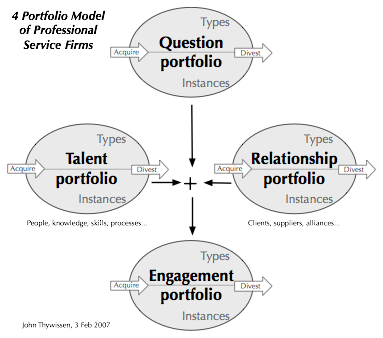Professional Service Firm Management
Introduction
References
References
J^T Thoughts

Developing Consultative Services as Part of a Larger Business
43 questions to think through carefully to develop the future of the firm's consultative services:
Current State
1. What is the current value proposition (statement)?
2. What is the NBCA (next best credible alternative)?
3. How are we differentiated for the NBCA?
4. What are our current capabilities?
Purpose / Mission
5. Why offer consultative services? What's the purpose?
6. Why not let others firms handle consultative matters?
7. What consultative matters do we want to engage on, and what do we want to refer?
8. Why have a separate unit focusing on consultative services? Can't we have all of the firm be "consultative"?
9. How does a "consultative" matter differ from other the firm work (like architecture & design), or does it? What's the dividing line?
10. How does current firm branding/positioning/advertising relate to the charter/scope of a consulting organization?
Vision
11. What should the firm's future consultative capabilities be?
12. What should the firm's consultative value statement be?
13. What would be the NBCA (next best credible alternative)?
14. How should we differentiate ourselves?
15. How to we quantify, in credible business results, the value statement and differentiation?
16. What are the key success factors (KSFs) for developing these?
Values & Culture
How do the firm values and the firm culture enable or hinder the current and future state of consulting?
| Current | Future | |
|---|---|---|
| Enable | 17. | 18. |
| Hinder | 19. | 20. |
4 Portfolio Model: Question portfolio, Talent portfolio, Relationship portfolio, Engagement portfolio
21. What is in our current question portfolio (types & instances)?
22. What is in our current talent portfolio (types & instances)?
23. What is in our current relationship portfolio (types & instances)?
24. What is in our current engagement portfolio (types & instances)?
25. What should be in our question portfolio (types & instances)?
26. What should be in our talent portfolio (types & instances)?
27. What should be in our relationship portfolio (types & instances)?
28. What should be in our engagement portfolio (types & instances)?
29. What should be our question portfolio management rules (acquisition criteria, divestiture criteria, yield management)?
30. What should be our talent portfolio management rules (acquisition criteria, divestiture criteria, yield management)?
31. What should be our relationship portfolio management rules (acquisition criteria, divestiture criteria, yield management)?
32. What should be our engagement portfolio management rules (acquisition criteria, divestiture criteria, yield management)?
Operations/Internal
33. How should a consulting org be internally "plugged-in" to / accessible to / part of extended team of sales?
34. How should a consulting org be internally "plugged-in" to / accessible to / part of extended team of account teams?
35. How should a consulting org be internally "plugged-in" to / accessible to / part of extended team of delivery?
36. In professional service organizations, marketing, sales, and delivery are not organizationally separated, because when selling talent, marketing, sales, and delivery are one continuous activity. How do we "de-fragment" ourselves for consulting services?
37. In professional service corporations (legal/accounting/medical/engineering/etc.), the firm is controlled and managed by licensed practitioners of the profession. (In fact, it’s illegal for a unlicensed person to control or manage such firms.) Should we place practicing consultants "in charge" of consulting?
38. If so, how do we manage the transition?
Strategies
39. Given the above, what are the gaps identified?
40. What trends inside the firm to we need to harness?
41. What trends outside the firm to we need to harness?
42. What strategies should we employ to close these gaps, and to harness these trends?
43. What are the objectives/goals and supporting initiatives to executing these strategies?